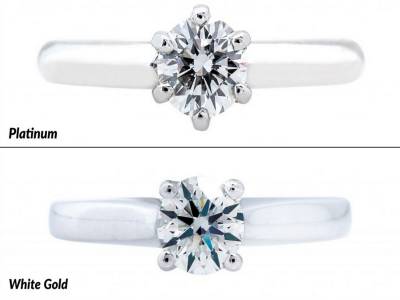A Very Unfair Fight between White Gold Vs Platinum

One thing you've already overruled is getting the classic yellow gold metal band for your wedding. But what you are still battling with is white gold vs platinum. It can be hard to make a pick between the two because of the closer similarity appearance. But then you wonder what the rivalry between the two is?
Some of the reasons you may first hesitate to make a quick selection are the components involved in making these metals, features, price, durability, and appearance. Let's check them out.
Durability: White gold vs platinum
So, which between these two wins the battle of durability? Platinum is 20 percent denser and more durable compared to white gold. It's not a surprise that it becomes a challenge to work with while molding the jewelry. That explains why it's 2-5 times more expensive than the white gold.
The durability of white gold varies with the Karats used in jewelry. For example, 18-carat gold has a high purity level, and its gold content is 75 percent and 25 percent alloys. A 14-carat has 58.3 percent gold and 41.7 percent pure alloys-making it longer-lasting and a better option.
However, they are both coated with Rhodium to strengthen and give them a shiny whiter hue.
Platinum is the epitome of strength and durability. It's ideal for bridegrooms, especially those who have a strenuous career, and are handy because it's pretty sturdy. It has a natural white hue and consists of 95 percent pure platinum, and the rest are alloy metals. These features make it stronger and more expensive than white gold.
Between white gold vs platinum, which will be more prone to damage? That will be white gold since it's a lighter metal and due to the alloy composition used.
Affordability and maintenance
White gold is the number one choice for those looking for bang for bucks and still want the quality white metal setting for their engagement or wedding band. Even as this is so, it's crucial to note the maintenance cost. White gold contains rhodium plating that helps to maintain the shiny white hue.
However, this coating wears out after some time of use and requires re-polishing. Although the charge is not that significant as it ranges from $60 to $120, it can be substantial if done yearly, depending on the metal's complexity.
Hypoallergenic
Do you know which metal between the two white gold vs platinum is hypoallergenic? If you have metal allergies such as nickel, you may want to avoid white gold, one of the alloys used in the white gold composition. Although it might be enticing with the price, this is something to be wary about if you or your partner is allergic. However, due to the Rhodium plating, it reduces the allergy as it covers the metal.
In contrast, platinum does not require nickel addition as it is 95 percent platinum, and the remainder may consist of other metals.
And for the recap:
Platinum:
- It is hypoallergenic, which is safer for the allergic individual
- Pretty durable compared to the white gold
- More solemn than white gold, which adds its value?
White gold:
- Lighter and more prone to damage
- Budget-friendlier than platinum, which can cost almost five times more
- More popular metal for engagement rings.
- Requires regular rhodium dipping to retain its shiny white color.
In conclusion, now, the ball is on your side. You can judge for yourself and say which metal between white gold vs platinum wins—diamond pairs well with either of these as it sparkles more.
- Comment
- Posted by Naman Modi